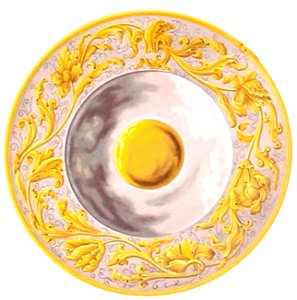— silver gilded censer of 1644. B — silver gilded censer of 1649. C — silver dish of tsar ivan alekseevich. The high significance which the orthodox church attaches to the censer used in worship prompts us to add to the historical and archaeological description of the two censers of the 17th century depicted here remarks on the origin, use and symbolism of incense and censers. All eastern, greek and latin trebniks and service books consider incense burning to be one of the essential accessories of worship. We find the beginning of this in the old testament rites. God himself commanded aaron through moses "to burn incense upon the ark, with sweet-smelling incense, early in the morning and in the evening, when the lamps are kindled" (exodus, xxx, 7 and 8). The apocalypse depicts for us the censing of an angel before the altar: "that he may offer up the prayers of the saints to god" (apocalypse, viii, 3). The most ancient evidence of the use of incense in the new testament church is found in the third rule of the holy apostles: "it is not lawful to bring anything to the altar, except oil for the holy lamp and incense during the divine ascension. " this evidence is supplemented by st. Dionysius the areopagite, who in his work "on the church hierarchy" (chapter 3) says that "the sacred rite began with the burning of incense before the altar and throughout the sanctuary. " the first example of a golden thuribulum is found in eugarius (hist. Eccles. , vi, 21). But the historian speaks of it as of an already known thing. And gregory the great confirms that no church rite is complete without the burning of incense and frankincense. Therefore, the story of platina in the life of sixtus i and the testimony of polydore virgil, as if leo iii was the first to introduce incense into the liturgy, are untrue. According to the teaching of the church, the burning of incense signifies not only the ascent of fervent prayers to god, but also the descent of the grace of the holy spirit, mysteriously delighting the souls of believers. “with each,” says st. Simeon of thessalonica, “holy places and things are honored, and those standing before them are sanctified. ” often this vessel represents the likeness of a one-domed church, such as, for example, the censer of st. Nikon in the trinity lavra. Censers shaped like a five-domed church are called patriarchal, because they were used in patriarchal services. The nikon tablet explains the symbolic meaning of all parts of the censer. A type of hand censer in some deserts and sketes is known under the name of katsei. The censers depicted here, silver with gilding, consist of two hemispherical cups, one covering the other. Their top is crowned with a church dome, on one with a four-pointed cross, and on the other with an eight-part cross. On the rim, an inscription in ligature shows that they were made during the reign of mikhail fedorovich in 1644. These censers, as well as the silver dish, remarkable for the elegance of the workmanship and antiquity, belong to the moscow merchant lavrov. Date: 1846—1853.
Loading...
